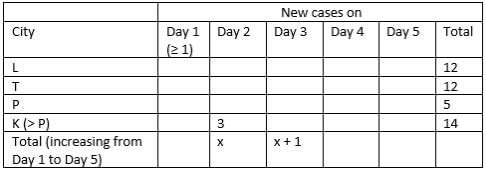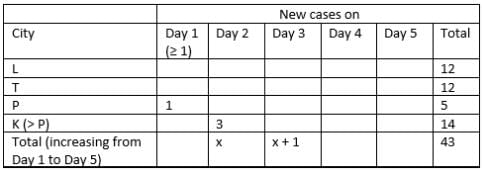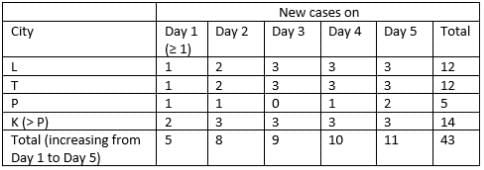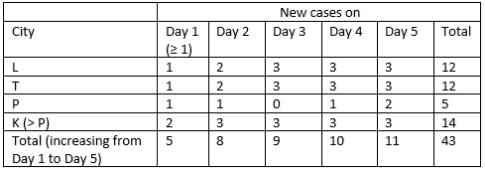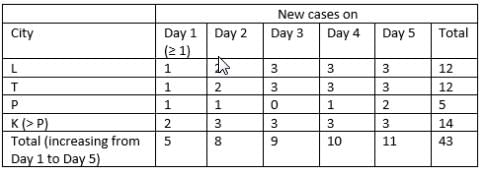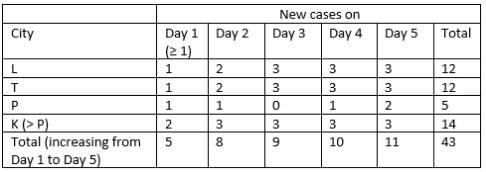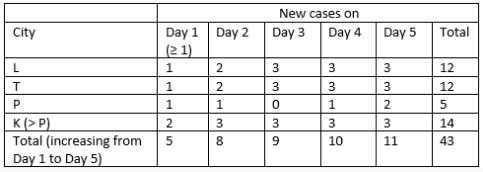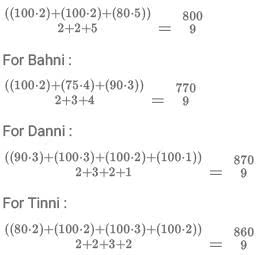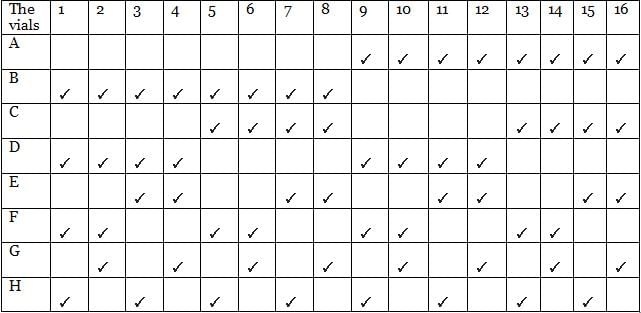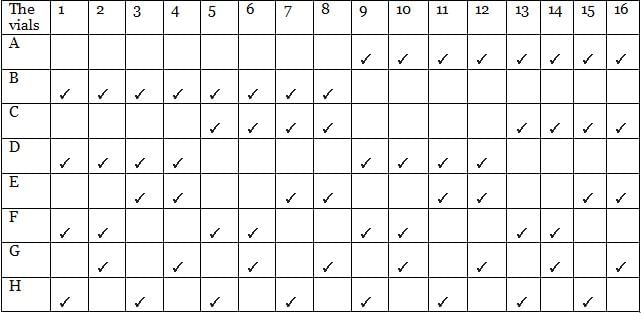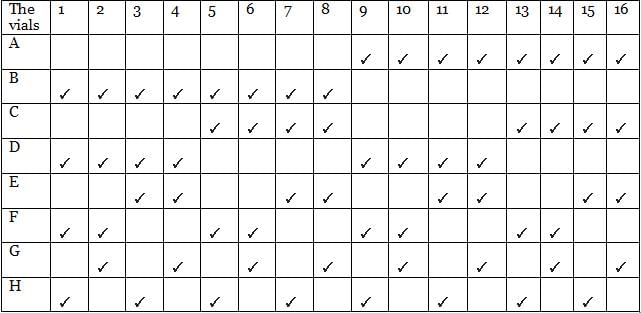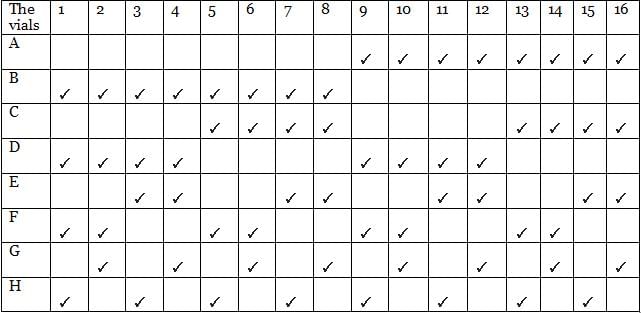Caselets- 2 CAT Previous Year Questions with Answer PDF
2022
Passage - 1
There are only four neighbourhoods in a city - Levmisto, Tyhrmisto, Pesmisto and Kitmisto. During the onset of a pandemic, the number of new cases of a disease in each of these neighbourhoods was recorded over a period of five days. On each day, the number of new cases recorded in any of the neighbourhoods was either 0, 1, 2 or 3.
The following facts are also known:
- On each of the five days, there were more new cases in Kitmisto than in Pesmisto.
- The number of new cases in the city in a day kept increasing during the five -day period. The number of new cases on Day 3 was exactly one more than that on Day 2.
- The maximum number of new cases in a day in Pesmisto was 2, and this happened only once during the five-day period.
- Kitmisto is the only place to have 3 new cases on Day 2.
- The total numbers of new cases in Levmisto, Tyhrmisto, Pesmisto and Kitmisto over the five-day period were 12, 12, 5 and 14 respectively.
- There was at least one new case in every neighbourhood on Day 1.
Q1: What BEST can be concluded about the total number of new cases in the city on Day 2?
(a) Either 7 or 8
(b) Either 6 or 7
(c) Exactly 7
(d) Exactly 8
Ans: d
Sol:
4 neighbourhoods (L, T, P, K) in a city. New cases each day were 0/1/2/3.
According to point (4) and Total 5 new cases in P throughout the 5 days, we can conclude that P had 0,1,1,1,2 new cases (in no particular order).
From point (1), we can conclude that there was 1 new case in P on Day 1
Day 5 has the max total. It should be 3+3+2+3 (from L to K) = 11
5+8+9+10+11 is the only possibility to get to a total of 43
The table can be filled as shown below without breaking much sweat. This was the second easiest set in this slot after the DI one.
The total number of new cases in the city on Day 2 were 8.
Q2: What BEST can be concluded about the number of new cases in Levmisto on Day 3?
(a) Exactly 2
(b) Either 2 or 3
(c) Either 0 or 1
(d) Exactly 3
Ans: d
Sol:
There were exactly 3 new cases in Levmisto on Day 3.
Q3: On which day(s) did Pesmisto not have any new case?
(a) Both Day 2 and Day 3
(b) Only Day 3
(c) Both Day 2 and Day 4
(d) Only Day 2
Ans: b
Pesmisto did not have any new case on Day 3.
Q4: Which of the two statements below is/are necessarily false?
Statement A: There were 2 new cases in Tyhrmisto on Day 3.
Statement B: There were no new cases in Pesmisto on Day 2.
(a) Neither Statement A nor Statement B
(b) Statement B only
(c) Both Statement A and Statement B
(d) Statement A only
Ans: c
Sol:
Both the statements are false.
Q5: On how many days did Levmisto and Tyhrmisto have the same number of new cases?
(a) 4
(b) 5
(c) 2
(d) 3
Ans: b
Sol:
Levmisto and Tyhrmisto have the same number of new cases on all the 5 days.
2021
Passage - 1
The figure above shows the schedule of four employees - Abani, Bahni, Danni, and Tinni - whom Dhoni supervised in 2020. Altogether there were five projects which started and concluded in 2020 in which they were involved. For each of these projects and for each employee, the starting day was at the beginning of a month and the concluding day was the end of a month, and these are indicated by the left and right end points of the corresponding horizontal bars. The number within each bar indicates the percentage of assigned work completed by the employee for that project, as assessed by Dhoni.
For each employee, his/her total project-month (in 2020) is the sum of the number of months (s)he worked across the five projects, while his/her annual completion index is the weightage average of the completion percentage assigned from the different projects, with the weights being the corresponding number of months (s)he worked in these projects. For each project, the total employee-month is the sum of the number of months four employees worked in this project, while its completion index is the weightage average of the completion percentage assigned for the employees who worked in this project, with the weights being the corresponding number of months they worked in this project.
Q1: Which of the following statements is/are true?
I: The total project-month was the same for the four employees.
II: The total employee-month was the same for the five projects.
(a) Only II
(b) Both I and II
(c) Neither I nor II
(d) Only I
Ans: d
Sol: The total project month is the number of months Abani, Bahni, Danni, and Tinni individually worked for all the projects combined :
Abani - 2+2+5 = 9 months
Bahni - 2+4+3 = 9 months
Danni - 3+3+2+1 = 9 months
Tinni - 2+2+3+2 = 9 months.
The total employee month for all the five projects is the sum of the total employee-month is the sum of the number of months four employees worked in this project.
Project -1 = 2+2+2 = 6 months
Project -2 = 3+2 = 5 months
Project - 3 = 2+4+3 = 9 months.
Project - 4 = 5+2+3 = 10 months.
Project - 5 = 3+1+2 = 6 months.
Only statement 1 is true.
Q2: Which employees did not work in multiple projects for any of the months in 2020?
(a) Only Abani, Bahni and Danni
(b) Only Abani and Bahni
(c) All four of them
(d) Only Tinni
Ans: a
Sol: Abani, Banni, and Danni did not work on multiple projects simultaneously in a month Tinni was the only person who worked on multiple projects which are project 4 and project 5 in the month of september.
Q3: The project duration, measured in terms of the number of months, is the time during which at least one employee worked in the project. Which of the following pairs of the projects had the same duration?
(a) Project 1, Project 5
(b) Project 4, Project 5
(c) Project 3, Project 5
(d) Project 3, Project 4
Ans: d
Sol: Considering the information provided :
For project 1 : 3 months.
Project - 2: 3 months.
Project - 3: 5 months.
Project - 4: 5 months.
Project - 5: 4 months.
Among the given options option D is true which is project 3, project 4.
Q4: The list of employees in decreasing order of annual completion index is:
(a) Danni, Tinni, Bahni, Abani
(b) Bahni, Abani, Tinni, Danni
(c) Danni, Tinni, Abani, Bahni
(d) Tinni, Danni, Abani, Bahni
Ans: c
Sol: The annual completion index for different people is :
The weightage average of the completion percentage assigned from the different projects, with the weights being the corresponding number of months (s)he worked in these projects.
For Abani :The descending order for the four people is :
Danni, Tinni, Abani, Bahni.
2020
Passage - 1
In a certain board examination, students were to appear for examination in five subjects: English, Hindi, Mathematics, Science and Social Science. Due to a certain emergency situation, a few of the examinations could not be conducted for some students. Hence, some students missed one examination and some others missed two examinations. Nobody missed more than two examinations.
The board adopted the following policy for awarding marks to students. If a student appeared in all five examinations, then the marks awarded in each of the examinations were on the basis of the scores obtained by them in those examinations.
If a student missed only one examination, then the marks awarded in that examination was the average of the best three among the four scores in the examinations they appeared for.
If a student missed two examinations, then the marks awarded in each of these examinations was the average of the best two among the three scores in the examinations they appeared for.
The marks obtained by six students in the examination are given in the table below. Each of them missed either one or two examinations.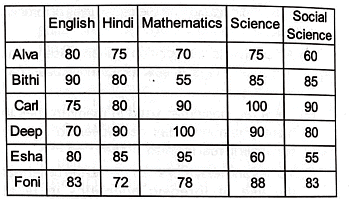 The following facts are also known.
The following facts are also known.
I. Four of these students appeared in each of the English, Hindi, Science, and Social Science examinations.
II. The student who missed the Mathematics examination did not miss any other examination.
III. One of the students who missed the Hindi examination did not miss any other examination.
The other student who missed the Hindi examination also missed the Science examination.
Q1: Who among the following did not appear for the Mathematics examination?
(a) Foni
(b) Alva
(c) Esha
(d) Carl
Ans: (d)
Sol: From the fourth paragraph, it is very clear that if the student miss exactly two exams, them his / her marks in those two subjects would be the average of best two scores and would also be “EQUAL”
By properly analysing the table, we can conclude that Esha is the only student who do not score equal marks in any two subjects. Hence, Esha is one of the student who missed exactly one subject.
Marks obtained by the student in the missed examination is the average of Best three scores, and the average/mean cannot be lowest or highest value.
Considering this concept of averages, Isha can miss examination of English, Hindi or Science.
If Esha missed English Exam, then her marks in that exam would be
Eventually she scored 80 only in English. Hence Esha could miss examination of English If Esha missed Hindi Exam, then her marks would be
This contradicts with value given the table if Esha missed science Exam, then her marks in science exam would beAgain contradiction
In conclusion, Esha missed the exam of exactly subject that is English
From the second fact, we can infer that one of student missed exam of only Mathematics. If Alva missed Maths exam, then her scored would be
This value contradicts with value given the table Hence Alva did not miss the Math Exam
If Bithi missed the Maths Exam, then her score would not be the lowest score (55)
If Carl missed the Maths exam, then his score would beCarl could be the student who missed the maths exam.
If Deep missed the Maths exam then he can’t score the highest marks of 100
If Foni missed the Maths exam then her score in that exam would be
This contradicts with value given in the table. In conclusion, Carl is the student who missed the exam of only mathematics.
From the third fact, we can conclude that one student missed only Hindi exam. Another student missed two exams one Hindi and one more. Two students among Alva, Bithi, Deep and Foni would be in this category.
If Alva missed only Hindi exam, then her score would bemarks score. If Alva missed two exams, then her score in both the exam would be equal.
Alva can miss Hindi and science, and her score in both these exam in the average ofmarks scored
In conclusion, Alva can miss only Hindi exam or Hindi and science both
If Bithi missed Hindi exam, then the score would be 90 + 85+ 85 or 86.6. The contradicts with value in the table
If Deep missed Hindi exam, then his score would beMakes score
If Deep missed Hindi and science, then his score would beAgain marks score
In conclusion Deep missed the exam of only Hindi or Hindi and science If Foni missed Hindi, then her score would be. This contradicts with value of given that table After analysing the third fact, we can conclude that one among Alwa and deep missed only Hindi and the other missed Hindi and science.
So far we have analysed missed exams as Alwa, Carl. Deep and Foni.
Only Bithi and Foni left
From the first fact, we can conclude that
Exactly two students missed English exam.
Exactly two students missed Hindi exam.
Exactly two students missed Science and Exactly two students missed Social, Science Social Science was missed by two students and those 2 students must be Bithi and Foni
We need to make sure apart from Esha, one more student missed English exam. Between Bithi and Foni, the scores are equal in Social score and English. In conclusion, Foni missed the exams of English and Social.
We also need to make sure apart from Alva or Deep, one more student missed Science exam and the only possibility is Bithi.
Alwa → Only Hindi or Hindi + Science
Bithi → Science and Social Science
Carl → Only mathematics
Deep → Only Hindi or Hindi and Science
Foni → English and social science
Q2: What BEST can be concluded about the students who did not appear for the Hindi examination?
(a) Alva and Deep
(b) Deep and Esha
(c) Alva and Esha
(d) Two among Alva, Deep and Esha
Ans: (a)
Sol: From the fourth paragraph, it is very clear that if the student miss exactly two exams, them his / her marks in those two subjects would be the average of best two scores and would also be “EQUAL”
By properly analysing the table, we can conclude that Esha is the only student who do not score equal marks in any two subjects. Hence, Esha is one of the student who missed exactly one subject.
Marks obtained by the student in the missed examination is the average of Best three scores, and the average/mean cannot be lowest or highest value.
Considering this concept of averages, Isha can miss examination of English, Hindi or Science.
If Esha missed English Exam, then her marks in that exam would be
Eventually she scored 80 only in English. Hence Esha could miss examination of English If Esha missed Hindi Exam, then her marks would be
This contradicts with value given the table if Esha missed science Exam, then her marks in science exam would beAgain contradiction
In conclusion, Esha missed the exam of exactly subject that is English
From the second fact, we can infer that one of student missed exam of only Mathematics. If Alva missed Maths exam, then her scored would be
This value contradicts with value given the table Hence Alva did not miss the Math Exam
If Bithi missed the Maths Exam, then her score would not be the lowest score (55)
If Carl missed the Maths exam, then his score would beCarl could be the student who missed the maths exam.
If Deep missed the Maths exam then he can’t score the highest marks of 100
If Foni missed the Maths exam then her score in that exam would be
This contradicts with value given in the table. In conclusion, Carl is the student who missed the exam of only mathematics.
From the third fact, we can conclude that one student missed only Hindi exam. Another student missed two exams one Hindi and one more. Two students among Alva, Bithi, Deep and Foni would be in this category.
If Alva missed only Hindi exam, then her score would bemarks score. If Alva missed two exams, then her score in both the exam would be equal.
Alva can miss Hindi and science, and her score in both these exam in the average ofmarks scored
In conclusion, Alva can miss only Hindi exam or Hindi and science both
If Bithi missed Hindi exam, then the score would be 90 + 85+ 85 or 86.6. The contradicts with value in the table
If Deep missed Hindi exam, then his score would beMakes score
If Deep missed Hindi and science, then his score would beAgain marks score
In conclusion Deep missed the exam of only Hindi or Hindi and science If Foni missed Hindi, then her score would be. This contradicts with value of given that table After analysing the third fact, we can conclude that one among Alwa and deep missed only Hindi and the other missed Hindi and science.
So far we have analysed missed exams as Alwa, Carl. Deep and Foni.
Only Bithi and Foni left
From the first fact, we can conclude that
Exactly two students missed English exam.
Exactly two students missed Hindi exam.
Exactly two students missed Science and Exactly two students missed Social, Science Social Science was missed by two students and those 2 students must be Bithi and Foni
We need to make sure apart from Esha, one more student missed English exam. Between Bithi and Foni, the scores are equal in Social score and English. In conclusion, Foni missed the exams of English and Social.
We also need to make sure apart from Alva or Deep, one more student missed Science exam and the only possibility is Bithi.
Alwa → Only Hindi or Hindi + Science
Bithi → Science and Social Science
Carl → Only mathematics
Deep → Only Hindi or Hindi and Science
Foni → English and social science
Q3: How many out of these six students missed exactly one examination?
Ans: 3
Sol: From the fourth paragraph, it is very clear that if the student miss exactly two exams, them his / her marks in those two subjects would be the average of best two scores and would also be “EQUAL”
By properly analysing the table, we can conclude that Esha is the only student who do not score equal marks in any two subjects. Hence, Esha is one of the student who missed exactly one subject.
Marks obtained by the student in the missed examination is the average of Best three scores, and the average/mean cannot be lowest or highest value.
Considering this concept of averages, Isha can miss examination of English, Hindi or Science.
If Esha missed English Exam, then her marks in that exam would be
Eventually she scored 80 only in English. Hence Esha could miss examination of English If Esha missed Hindi Exam, then her marks would be
This contradicts with value given the table if Esha missed science Exam, then her marks in science exam would beAgain contradiction
In conclusion, Esha missed the exam of exactly subject that is English
From the second fact, we can infer that one of student missed exam of only Mathematics. If Alva missed Maths exam, then her scored would be
This value contradicts with value given the table Hence Alva did not miss the Math Exam
If Bithi missed the Maths Exam, then her score would not be the lowest score (55)
If Carl missed the Maths exam, then his score would beCarl could be the student who missed the maths exam.
If Deep missed the Maths exam then he can’t score the highest marks of 100
If Foni missed the Maths exam then her score in that exam would be
This contradicts with value given in the table. In conclusion, Carl is the student who missed the exam of only mathematics.
From the third fact, we can conclude that one student missed only Hindi exam. Another student missed two exams one Hindi and one more. Two students among Alva, Bithi, Deep and Foni would be in this category.
If Alva missed only Hindi exam, then her score would bemarks score. If Alva missed two exams, then her score in both the exam would be equal.
Alva can miss Hindi and science, and her score in both these exam in the average ofmarks scored
In conclusion, Alva can miss only Hindi exam or Hindi and science both
If Bithi missed Hindi exam, then the score would be 90 + 85+ 85 or 86.6. The contradicts with value in the table
If Deep missed Hindi exam, then his score would beMakes score
If Deep missed Hindi and science, then his score would beAgain marks score
In conclusion Deep missed the exam of only Hindi or Hindi and science If Foni missed Hindi, then her score would be. This contradicts with value of given that table After analysing the third fact, we can conclude that one among Alwa and deep missed only Hindi and the other missed Hindi and science.
So far we have analysed missed exams as Alwa, Carl. Deep and Foni.
Only Bithi and Foni left
From the first fact, we can conclude that
Exactly two students missed English exam.
Exactly two students missed Hindi exam.
Exactly two students missed Science and Exactly two students missed Social, Science Social Science was missed by two students and those 2 students must be Bithi and Foni
We need to make sure apart from Esha, one more student missed English exam. Between Bithi and Foni, the scores are equal in Social score and English. In conclusion, Foni missed the exams of English and Social.
We also need to make sure apart from Alva or Deep, one more student missed Science exam and the only possibility is Bithi.
Alwa → Only Hindi or Hindi + Science
Bithi → Science and Social Science
Carl → Only mathematics
Deep → Only Hindi or Hindi and Science
Foni → English and social science
Q4: Which students did not appear for the English examination?
(a) Alva and Bithi
(b) Carl and Deep
(c) Esha and Foni
(d) Cannot be determined
Ans: (c)
Sol: From the fourth paragraph, it is very clear that if the student miss exactly two exams, them his / her marks in those two subjects would be the average of best two scores and would also be “EQUAL”
By properly analysing the table, we can conclude that Esha is the only student who do not score equal marks in any two subjects. Hence, Esha is one of the student who missed exactly one subject.
Marks obtained by the student in the missed examination is the average of Best three scores, and the average/mean cannot be lowest or highest value.
Considering this concept of averages, Isha can miss examination of English, Hindi or Science.
If Esha missed English Exam, then her marks in that exam would be
Eventually she scored 80 only in English. Hence Esha could miss examination of English If Esha missed Hindi Exam, then her marks would be
This contradicts with value given the table if Esha missed science Exam, then her marks in science exam would beAgain contradiction
In conclusion, Esha missed the exam of exactly subject that is English
From the second fact, we can infer that one of student missed exam of only Mathematics. If Alva missed Maths exam, then her scored would be
This value contradicts with value given the table Hence Alva did not miss the Math Exam
If Bithi missed the Maths Exam, then her score would not be the lowest score (55)
If Carl missed the Maths exam, then his score would beCarl could be the student who missed the maths exam.
If Deep missed the Maths exam then he can’t score the highest marks of 100
If Foni missed the Maths exam then her score in that exam would be
This contradicts with value given in the table. In conclusion, Carl is the student who missed the exam of only mathematics.
From the third fact, we can conclude that one student missed only Hindi exam. Another student missed two exams one Hindi and one more. Two students among Alva, Bithi, Deep and Foni would be in this category.
If Alva missed only Hindi exam, then her score would bemarks score. If Alva missed two exams, then her score in both the exam would be equal.
Alva can miss Hindi and science, and her score in both these exam in the average ofmarks scored
In conclusion, Alva can miss only Hindi exam or Hindi and science both
If Bithi missed Hindi exam, then the score would be 90 + 85+ 85 or 86.6. The contradicts with value in the table
If Deep missed Hindi exam, then his score would beMakes score
If Deep missed Hindi and science, then his score would beAgain marks score
In conclusion Deep missed the exam of only Hindi or Hindi and science If Foni missed Hindi, then her score would be. This contradicts with value of given that table After analysing the third fact, we can conclude that one among Alwa and deep missed only Hindi and the other missed Hindi and science.
So far we have analysed missed exams as Alwa, Carl. Deep and Foni.
Only Bithi and Foni left
From the first fact, we can conclude that
Exactly two students missed English exam.
Exactly two students missed Hindi exam.
Exactly two students missed Science and Exactly two students missed Social, Science Social Science was missed by two students and those 2 students must be Bithi and Foni
We need to make sure apart from Esha, one more student missed English exam. Between Bithi and Foni, the scores are equal in Social score and English. In conclusion, Foni missed the exams of English and Social.
We also need to make sure apart from Alva or Deep, one more student missed Science exam and the only possibility is Bithi.
Alwa → Only Hindi or Hindi + Science
Bithi → Science and Social Science
Carl → Only mathematics
Deep → Only Hindi or Hindi and Science
Foni → English and social science
Q5: What BEST can be concluded about the students who missed the Science examination?
(a) Alva and Bithi
(b) Deep and Bithi
(c) Alva and Deep
(d) Bithi and one out of Alva and Deep
Ans: (d)
Sol: From the fourth paragraph, it is very clear that if the student miss exactly two exams, them his / her marks in those two subjects would be the average of best two scores and would also be “EQUAL”
By properly analysing the table, we can conclude that Esha is the only student who do not score equal marks in any two subjects. Hence, Esha is one of the student who missed exactly one subject.
Marks obtained by the student in the missed examination is the average of Best three scores, and the average/mean cannot be lowest or highest value.
Considering this concept of averages, Isha can miss examination of English, Hindi or Science.
If Esha missed English Exam, then her marks in that exam would be
Eventually she scored 80 only in English. Hence Esha could miss examination of English If Esha missed Hindi Exam, then her marks would be
This contradicts with value given the table if Esha missed science Exam, then her marks in science exam would beAgain contradiction
In conclusion, Esha missed the exam of exactly subject that is English
From the second fact, we can infer that one of student missed exam of only Mathematics. If Alva missed Maths exam, then her scored would be
This value contradicts with value given the table Hence Alva did not miss the Math Exam
If Bithi missed the Maths Exam, then her score would not be the lowest score (55)
If Carl missed the Maths exam, then his score would beCarl could be the student who missed the maths exam.
If Deep missed the Maths exam then he can’t score the highest marks of 100
If Foni missed the Maths exam then her score in that exam would be
This contradicts with value given in the table. In conclusion, Carl is the student who missed the exam of only mathematics.
From the third fact, we can conclude that one student missed only Hindi exam. Another student missed two exams one Hindi and one more. Two students among Alva, Bithi, Deep and Foni would be in this category.
If Alva missed only Hindi exam, then her score would bemarks score. If Alva missed two exams, then her score in both the exam would be equal.
Alva can miss Hindi and science, and her score in both these exam in the average ofmarks scored
In conclusion, Alva can miss only Hindi exam or Hindi and science both
If Bithi missed Hindi exam, then the score would be 90 + 85+ 85 or 86.6. The contradicts with value in the table
If Deep missed Hindi exam, then his score would beMakes score
If Deep missed Hindi and science, then his score would beAgain marks score
In conclusion Deep missed the exam of only Hindi or Hindi and science If Foni missed Hindi, then her score would be. This contradicts with value of given that table After analysing the third fact, we can conclude that one among Alwa and deep missed only Hindi and the other missed Hindi and science.
So far we have analysed missed exams as Alwa, Carl. Deep and Foni.
Only Bithi and Foni left
From the first fact, we can conclude that
Exactly two students missed English exam.
Exactly two students missed Hindi exam.
Exactly two students missed Science and Exactly two students missed Social, Science Social Science was missed by two students and those 2 students must be Bithi and Foni
We need to make sure apart from Esha, one more student missed English exam. Between Bithi and Foni, the scores are equal in Social score and English. In conclusion, Foni missed the exams of English and Social.
We also need to make sure apart from Alva or Deep, one more student missed Science exam and the only possibility is Bithi.
Alwa → Only Hindi or Hindi + Science
Bithi → Science and Social Science
Carl → Only mathematics
Deep → Only Hindi or Hindi and Science
Foni → English and social science
Q6: For how many students can we be definite about which examinations they missed?
Ans: 4
Sol: From the fourth paragraph, it is very clear that if the student miss exactly two exams, them his / her marks in those two subjects would be the average of best two scores and would also be “EQUAL”
By properly analysing the table, we can conclude that Esha is the only student who do not score equal marks in any two subjects. Hence, Esha is one of the student who missed exactly one subject.
Marks obtained by the student in the missed examination is the average of Best three scores, and the average/mean cannot be lowest or highest value.
Considering this concept of averages, Isha can miss examination of English, Hindi or Science.
If Esha missed English Exam, then her marks in that exam would be
Eventually she scored 80 only in English. Hence Esha could miss examination of English If Esha missed Hindi Exam, then her marks would be
This contradicts with value given the table if Esha missed science Exam, then her marks in science exam would beAgain contradiction
In conclusion, Esha missed the exam of exactly subject that is English
From the second fact, we can infer that one of student missed exam of only Mathematics. If Alva missed Maths exam, then her scored would be
This value contradicts with value given the table Hence Alva did not miss the Math Exam
If Bithi missed the Maths Exam, then her score would not be the lowest score (55)
If Carl missed the Maths exam, then his score would beCarl could be the student who missed the maths exam.
If Deep missed the Maths exam then he can’t score the highest marks of 100
If Foni missed the Maths exam then her score in that exam would be
This contradicts with value given in the table. In conclusion, Carl is the student who missed the exam of only mathematics.
From the third fact, we can conclude that one student missed only Hindi exam. Another student missed two exams one Hindi and one more. Two students among Alva, Bithi, Deep and Foni would be in this category.
If Alva missed only Hindi exam, then her score would bemarks score. If Alva missed two exams, then her score in both the exam would be equal.
Alva can miss Hindi and science, and her score in both these exam in the average ofmarks scored
In conclusion, Alva can miss only Hindi exam or Hindi and science both
If Bithi missed Hindi exam, then the score would be 90 + 85+ 85 or 86.6. The contradicts with value in the table
If Deep missed Hindi exam, then his score would beMakes score
If Deep missed Hindi and science, then his score would beAgain marks score
In conclusion Deep missed the exam of only Hindi or Hindi and science If Foni missed Hindi, then her score would be. This contradicts with value of given that table After analysing the third fact, we can conclude that one among Alwa and deep missed only Hindi and the other missed Hindi and science.
So far we have analysed missed exams as Alwa, Carl. Deep and Foni.
Only Bithi and Foni left
From the first fact, we can conclude that
Exactly two students missed English exam.
Exactly two students missed Hindi exam.
Exactly two students missed Science and Exactly two students missed Social, Science Social Science was missed by two students and those 2 students must be Bithi and Foni
We need to make sure apart from Esha, one more student missed English exam. Between Bithi and Foni, the scores are equal in Social score and English. In conclusion, Foni missed the exams of English and Social.
We also need to make sure apart from Alva or Deep, one more student missed Science exam and the only possibility is Bithi.
Alwa → Only Hindi or Hindi + Science
Bithi → Science and Social Science
Carl → Only mathematics
Deep → Only Hindi or Hindi and Science
Foni → English and social science
Passage - 2
Sixteen patients in a hospital must undergo a blood test for a disease. It is known that exactly one of them has the disease. The hospital has only eight testing kits and has decided to pool blood samples of patients into eight vials for the tests. The patients are numbered 1 through 16, and the vials are labelled A, B, C, D, E, F, G, and H. The following table shows the vials into which each patient’s blood sample is distributed.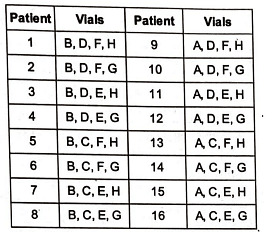 If a patient has the disease, then each vial containing his/her blood sample will test positive. If a vial tests positive, one of the patients whose blood samples were mixed in the vial has the disease. If a vial tests negative, then none of the patients whose blood samples were mixed in the vial has the disease.
If a patient has the disease, then each vial containing his/her blood sample will test positive. If a vial tests positive, one of the patients whose blood samples were mixed in the vial has the disease. If a vial tests negative, then none of the patients whose blood samples were mixed in the vial has the disease.
Q1: Suppose vial C tests positive and vials A, E and H test negative. Which patient has the disease?
(a) Patient 14
(b) Patient 2
(c) Patient 6
(d) Patient 8
Ans: (c)
Sol:
This table helps to figure out that vials A & B, viable C & D, Vials E & F, Vials G & H cannot be negative simultaneously. As each group consists exclusive set of patients
If vial C tests positive vials A , E and H test negative . If vial C tests positive following patients can have disease.
Patient No. 5, 6, 7, 8, 13, 14, 15 & 16
If vials A, E & H test negative ⇒ following patients can’t have disease
Patients who can’t have disease are :
Patient No. 5, 7, 8, 13, 14, 15 & 16 ⇒ Patient 6 must have disease
Q2: Which of the following combinations of test results is NOT possible?
(a) Vials A and G positive, vials D and E negative
(b) Vials B and D positive, vials F and H negative
(c) Vial B positive, vials C, F and H negative
(d) Vials A and E positive, vials C and D negative
Ans: (d)
Sol:
This table helps to figure out that vials A & B, viable C & D, Vials E & F, Vials G & H cannot be negative simultaneously. As each group consists exclusive set of patients
If vials C & D test negative, that means none of the patients through 16 have diseases. But its given in the questions, that exactly one of the patients has disease. This is not possible.
Q3: Suppose vial A tests positive and vials D and G test negative. Which of the following vials should we test next to identify the patient with the disease?
(a) Vial E
(b) Vial H
(c) Vial C
(d) Vial B
Ans: (a)
Sol:
This table helps to figure out that vials A & B, viable C & D, Vials E & F, Vials G & H cannot be negative simultaneously. As each group consists exclusive set of patients
If vial a tests positive, then following patients can have disease.
Patient No. 9,10,11,12,13,14,15,16 → (1)
Vials D \& G test negative
⇒ Following patients, can't have disease patients
No : - 1,2,3,4,6,8,9,10,11,12,14, \& 16 → (2)
From both 1 \&2, we ca say that patient No .13 or patient No. 15 can have disease.
Now we have eliminate or find out who among patient 13 or patient 15 has disease. So we should test vials E or F
Q4: Suppose one of the lab assistants accidentally mixed two patients' blood samples before they were distributed to the vials. Which of the following correctly represents the set of all possible numbers of positive test results out of the eight vials?
(a) {4,5}
(b) {5,6,7,8}
(c) {4,5,6,7,8}
(d) {4,5,6,7}
Ans: (c)
Sol:
This table helps to figure out that vials A & B, viable C & D, Vials E & F, Vials G & H cannot be negative simultaneously. As each group consists exclusive set of patients
i) Let’s assume one of the patients, patient 1 or patient 16 has disease and that patients blood is mixed with other them all 8 vials will test positive. 8 has to be one of the answers.
ii) If patient 2 and patients 16’s blood is mixed of one of them has disease then 7 of the 8 vials will test positive. So 7 has to be there in the option.
iii) Let’s assume patient 1 has disease, if his blood is not mixed, then 4 vials will definitely show positive. So 4 also has to be there in answer. So the answer must definitely contain 4, 7 and 8
|
77 videos|180 docs|96 tests
|
FAQs on Caselets- 2 CAT Previous Year Questions with Answer PDF
| 1. What is CAT 2020? |  |
| 2. What are the Caselets in CAT? |  |
| 3. How can I prepare for the Caselets in CAT 2020? |  |
| 4. What is the difficulty level of the Caselets in CAT? |  |
| 5. How can I improve my performance in the Caselets section of CAT? |  |

